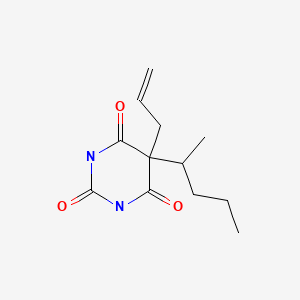Attribution Statement: LactMed is a registered trademark of the U.S. Department of Health and Human Services.
NCBI Bookshelf. A service of the National Library of Medicine, National Institutes of Health.
Drugs and Lactation Database (LactMed®) [Internet]. Bethesda (MD): National Institute of Child Health and Human Development; 2006-.
CASRN: 76-73-3

Drug Levels and Effects
Summary of Use during Lactation
Because there is little published experience with secobarbital during breastfeeding, other agents may be preferred, especially while nursing a newborn or preterm infant. If secobarbital is used, monitor the infant for sedation, poor feeding and poor weight gain.
Drug Levels
Maternal Levels. Secobarbital was detected but not quantified 24 hours after an unspecified dose in a woman who was 4 days postpartum.[1]
Infant Levels. Relevant published information was not found as of the revision date.
Effects in Breastfed Infants
Relevant published information was not found as of the revision date.
Effects on Lactation and Breastmilk
Secobarbital 200 mg given intravenously during labor 10 minutes to 3 hours before delivery for obstetric sedation reduced the sucking behavior of the newborn infants. The number of sucks, sucking pressure and total consumption of artificial feeding from the testing device were reduced Secobarbital 200 mg given intravenously during labor 10 minutes to 3 hours before delivery for obstetric sedation reduced the sucking behavior of the newborn infants. The number of sucks, sucking pressure and total consumption of artificial feeding from the testing device were reduced substantially.[2]
In one small study, women given promethazine with meperidine and secobarbital during labor, had the time to lactogenesis II prolonged by 14 hours. Women given meperidine or secobarbital without promethazine had lactogenesis II prolonged 7 hours compared to unmedicated women, but the difference was not statistically significant.[3]
References
- 1.
- Horning MG, Stillwell WG, Nowlin J, et al. Identification and quantification of drugs and drug metabolites in human breast milk using GC-MS-COM methods. Mod Probl Paediatr. 1975;15:73–9.
- 2.
- Kron RE, Stein M, Goddard KE. Newborn sucking behavior affected by obstetric sedation. Pediatrics. 1966;37:1012–6. [PubMed: 5949020]
- 3.
- Hildebrandt HM. Maternal perception of lactogenesis time: A clinical report. J Hum Lact. 1999;15:317–23. [PubMed: 10776182]
Substance Identification
Substance Name
Secobarbital
CAS Registry Number
76-73-3
Disclaimer: Information presented in this database is not meant as a substitute for professional judgment. You should consult your healthcare provider for breastfeeding advice related to your particular situation. The U.S. government does not warrant or assume any liability or responsibility for the accuracy or completeness of the information on this Site.
- User and Medical Advice Disclaimer
- Drugs and Lactation Database (LactMed) - Record Format
- LactMed - Database Creation and Peer Review Process
- Fact Sheet. Drugs and Lactation Database (LactMed)
- Drugs and Lactation Database (LactMed) - Glossary
- LactMed Selected References
- Drugs and Lactation Database (LactMed) - About Dietary Supplements
- Breastfeeding Links
- PubChem SubstanceRelated PubChem Substances
- PubMedLinks to PubMed
- Review Pentobarbital.[Drugs and Lactation Database (...]Review Pentobarbital.. Drugs and Lactation Database (LactMed®). 2006
- Review Butabarbital.[Drugs and Lactation Database (...]Review Butabarbital.. Drugs and Lactation Database (LactMed®). 2006
- Review Butalbital.[Drugs and Lactation Database (...]Review Butalbital.. Drugs and Lactation Database (LactMed®). 2006
- Review Thiopental.[Drugs and Lactation Database (...]Review Thiopental.. Drugs and Lactation Database (LactMed®). 2006
- Metabolism of quinalbarbitone.[J Pharm Pharmacol. 1975]Metabolism of quinalbarbitone.Gilbert JN, Hetherington WL, Powell JW, Whalley WB. J Pharm Pharmacol. 1975 May; 27(5):343-7.
- Secobarbital - Drugs and Lactation Database (LactMed®)Secobarbital - Drugs and Lactation Database (LactMed®)
Your browsing activity is empty.
Activity recording is turned off.
See more...
